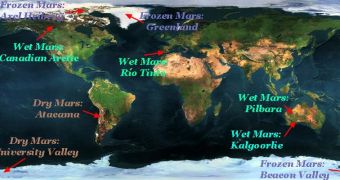Investigators figured out a few years ago that certain locations on our planet tend to mimic conditions that most likely existed on Mars millions to billions of years ago. Studies conducted at these spots are currently being put together to create a timeline of how things evolved on the Red Planet.
One of the main reasons why such investigations need to be conducted is that they could hold the key that would allow us to understand the readings and datasets sent back by robotic missions to Mars in more detail.
At this point, some of the results sent back by landers, rovers and orbiters are contradictory and puzzling, and some scientists are convinced we can't make sense of them simply because we don't know a lot about the planet's history.
While no location on Earth will be able to mimic places on our neighboring planet to the smallest detail, they could provide enough insight to help us make sense of incoming data.
An added advantage of studying these places is that they could provide us with a more detailed understanding of the boundaries between which life can endure.
Recent discoveries, such as the one NASA exobiologists reported in the journal Science on December 2, indicate that there might be more to how lifeforms can survive in extreme environments than meets the eye.
There's no longer a secret to anyone that Mars changed over time, and that, at one point, it even featured flowing rivers of liquid water, as well as a large ocean covering much of its Northern Hemisphere.
But changes in its orbital inclination as well as geological processes eventually made the planet develop into the freezing and barren wasteland it is today. Its waters are not gone however.
The NASA Phoenix Mars Lander discovered them in 2008, located underneath a thin layer of red sand near the planet's north pole.
“We have tried to assign every analog to a specific time in Mars' geological history, so we can study the evolution of Mars in Earth environments,” explains SETI Institute astrobiologist Alberto Fairen.
“This will be the only way to ask ourselves the right questions,” adds the expert, who also holds an appointment at the NASA Ames Research Center.
A study on the issue is published in the November issue of the esteemed journal Astrobiology, Space reports.

 14 DAY TRIAL //
14 DAY TRIAL //